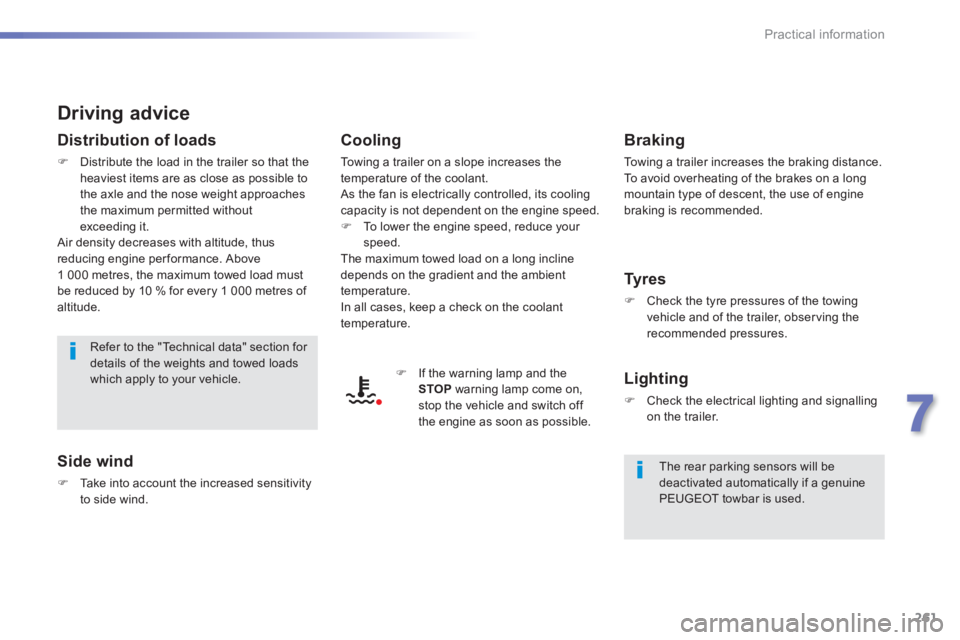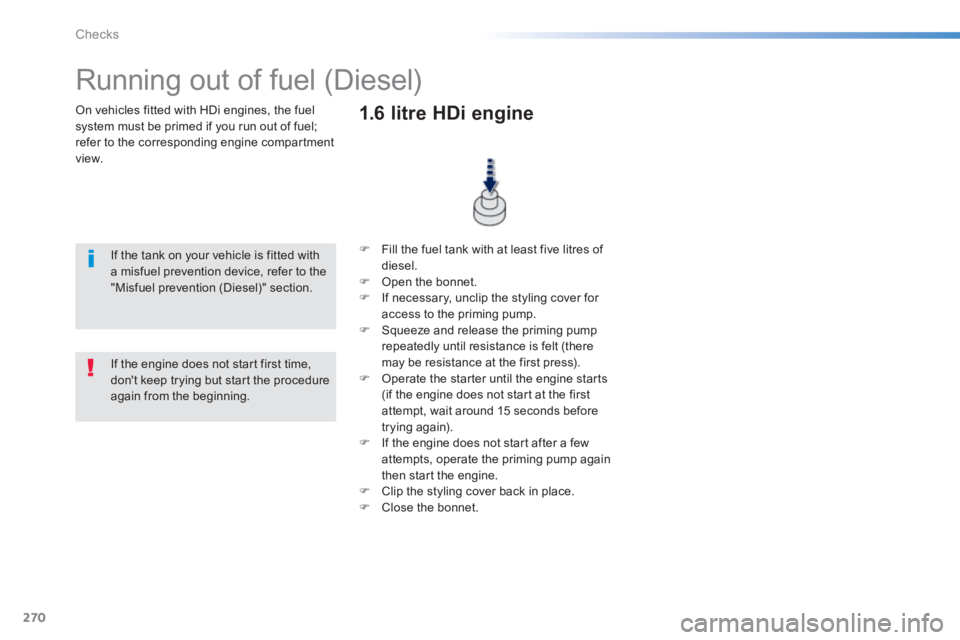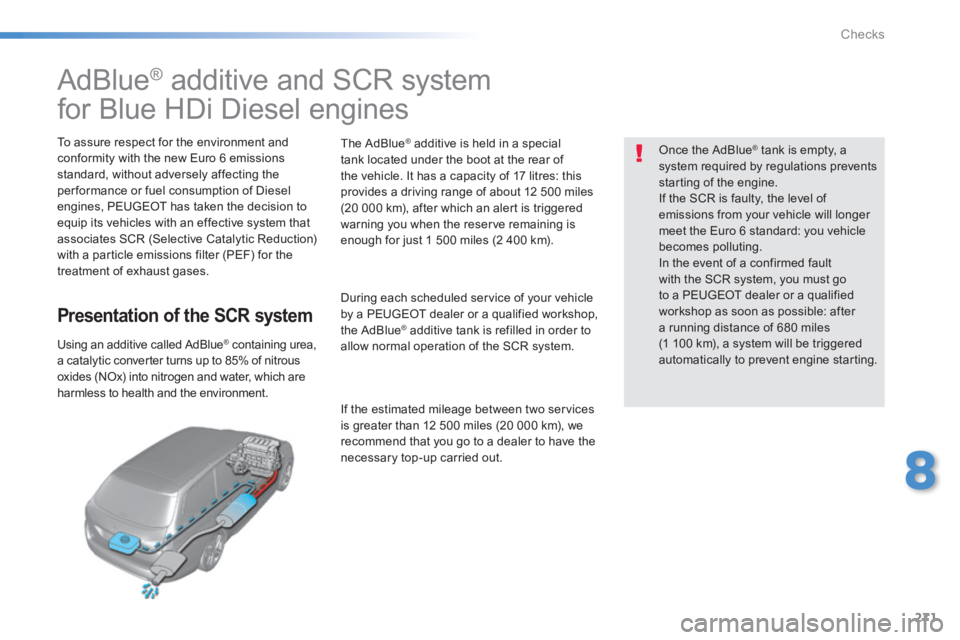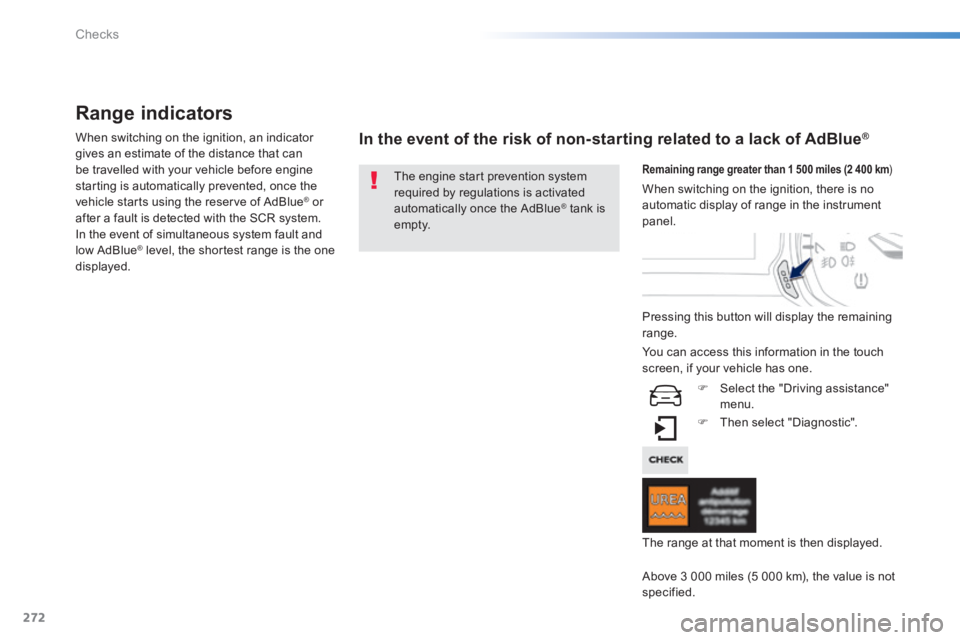Page 263 of 400

261
7
Practical information
Driving advice
Distribution of loads
Distribute the load in the trailer so that the heaviest items are as close as possible to the axle and the nose weight approaches the maximum permitted without
exceeding it. Air density decreases with altitude, thus reducing engine performance. Above 1 000 metres, the maximum towed load must be reduced by 10 % for every 1 000 metres of altitude.
Side wind
Take into account the increased sensitivity to side wind.
Cooling
Towing a trailer on a slope increases the temperature of the coolant. As the fan is electrically controlled, its cooling capacity is not dependent on the engine speed.
To lower the engine speed, reduce your speed. The maximum towed load on a long incline depends on the gradient and the ambient temperature. In all cases, keep a check on the coolant temperature.
If the warning lamp and the STOP warning lamp come on, stop the vehicle and switch off the engine as soon as possible.
Braking
Towing a trailer increases the braking distance. To avoid overheating of the brakes on a long mountain type of descent, the use of engine braking is recommended.
Ty r e s
Check the tyre pressures of the towing vehicle and of the trailer, observing the recommended pressures.
Lighting
Check the electrical lighting and signalling on the trailer.
The rear parking sensors will be deactivated automatically if a genuine PEUGEOT towbar is used.
Refer to the "Technical data" section for details of the weights and towed loads which apply to your vehicle.
Page 268 of 400
266
Checks
PEUGEOT & TOTAL
Partners in performance and
protection of the environment
Innovation at the service of performance
The TOTAL Research and Development teams develop lubricants for PEUGEOT which satisfy the requirements of the latest technical innovations incorporated in PEUGEOT vehicles. This ensures that you obtain the best per formance and the maximum engine life.
Reduced exhaust emissions
TOTAL lubricants are formulated to optimise the efficiency of engines and the protection of the emissions post-treatment systems. It is crucial to
observe the servicing recommendations made by PEUGEOT to ensure correct operation.
RECOMMENDS RECOMMENDS
Page 269 of 400
267
8
Checks
Bonnet
Before doing anything under the bonnet, switch off the Stop & Start system to avoid any risk of injury resulting from an automatic change to START mode.
Opening
Closing
Take the stay out of its support slot. Clip the stay back into its housing. Lower the bonnet and release it at the end of its travel. Pull on the bonnet to check that it has latched correctly.
Unclip the stay from its housing and place it in the support slot to hold the bonnet open.
Do not open the bonnet under very windy conditions.
When the engine is hot, handle the exterior safety catch and the stay with care (risk of burns). To avoid damaging electrical units, it is strictly forbidden to use a high pressure jet wash under the bonnet.
Pull the safety catch towards you, then raise the bonnet.
Open the door.
Pull the release lever, located at the bottom of the door aperture, towards you.
Page 270 of 400
268
Checks
The various caps and covers allow access for checking the levels of the various fluids and for replacing certain components.
Petrol engine
1. Screenwash and headlamp wash reservoir. 2. Coolant reservoir. 3. Brake fluid filler. 4. Battery / Fuses.
5. Fusebox. 6. Air filter. 7. Engine oil dipstick. 8. Engine oil filler cap.
This engine is shown as an example. The locations of the engine oil dipstick and filler cap may vary.
Page 271 of 400
269
8
Checks
The various caps and covers allow access for checking the levels of the various fluids, for replacing certain components and for priming the fuel system.
* According to engine.
Diesel engine
1. Screenwash and headlamp wash reservoir. 2. Coolant reservoir. 3. Brake fluid filler. 4. Battery / Fuses. 5. Fusebox. 6. Air filter. 7. Engine oil dipstick. 8. Engine oil filler cap. 9. Priming pump * .
This engine is shown as an example. The locations of the engine oil dipstick and filler cap may vary.
Page 272 of 400

270
Checks
On vehicles fitted with HDi engines, the fuel system must be primed if you run out of fuel; refer to the corresponding engine compartment view.
Running out of fuel (Diesel)
If the tank on your vehicle is fitted with a misfuel prevention device, refer to the "Misfuel prevention (Diesel)" section.
Fill the fuel tank with at least five litres of diesel. Open the bonnet. If necessary, unclip the styling cover for access to the priming pump. Squeeze and release the priming pump repeatedly until resistance is felt (there may be resistance at the first press). Operate the starter until the engine starts (if the engine does not start at the first attempt, wait around 15 seconds before trying again). If the engine does not start after a few attempts, operate the priming pump again then start the engine. Clip the styling cover back in place. Close the bonnet.
1.6 litre HDi engine
If the engine does not start first time, don't keep trying but start the procedure again from the beginning.
Page 273 of 400

271
8
Checks
AdBlue ® additive and SCR system
for Blue HDi Diesel engines
To assure respect for the environment and conformity with the new Euro 6 emissions standard, without adversely affecting the per formance or fuel consumption of Diesel engines, PEUGEOT has taken the decision to equip its vehicles with an effective system that associates SCR (Selective Catalytic Reduction) with a particle emissions filter (PEF) for the treatment of exhaust gases.
Presentation of the SCR system
Using an additive called AdBlue ® containing urea, ® containing urea, ®
a catalytic converter turns up to 85% of nitrous oxides (NOx) into nitrogen and water, which are harmless to health and the environment.
The AdBlue ® additive is held in a special ® additive is held in a special ®
tank located under the boot at the rear of the vehicle. It has a capacity of 17 litres: this provides a driving range of about 12 500 miles (20 000 km), after which an alert is triggered warning you when the reserve remaining is enough for just 1 500 miles (2 400 km).
During each scheduled service of your vehicle by a PEUGEOT dealer or a qualified workshop, the AdBlue ® additive tank is refilled in order to ® additive tank is refilled in order to ®
allow normal operation of the SCR system.
If the estimated mileage between two services is greater than 12 500 miles (20 000 km), we recommend that you go to a dealer to have the necessary top-up carried out.
Once the AdBlue ® tank is empty, a ® tank is empty, a ®
system required by regulations prevents starting of the engine. If the SCR is faulty, the level of emissions from your vehicle will longer meet the Euro 6 standard: you vehicle becomes polluting. In the event of a confirmed fault with the SCR system, you must go to a PEUGEOT dealer or a qualified workshop as soon as possible: after a running distance of 680 miles (1 100 km), a system will be triggered automatically to prevent engine starting.
Page 274 of 400

272
Checks
Range indicators
When switching on the ignition, an indicator gives an estimate of the distance that can be travelled with your vehicle before engine starting is automatically prevented, once the vehicle starts using the reserve of AdBlue ® or ® or ®
after a fault is detected with the SCR system. In the event of simultaneous system fault and low AdBlue ® level, the shortest range is the one ® level, the shortest range is the one ®
displayed.
In the event of the risk of non-starting related to a lack of AdBlue ® In the event of the risk of non-starting related to a lack of AdBlue ® In the event of the risk of non-starting related to a lack of AdBlue
The engine start prevention system required by regulations is activated automatically once the AdBlue ® tank is ® tank is ®
e m pt y.
Remaining range greater than 1 500 miles (2 400 km ) miles (2 400 km ) miles (2 400 km
Pressing this button will display the remaining range.
Then select "Diagnostic".
Above 3 000 miles (5 000 km), the value is not specified.
When switching on the ignition, there is no automatic display of range in the instrument panel.
The range at that moment is then displayed.
You can access this information in the touch screen, if your vehicle has one.
Select the "Driving assistance" menu.